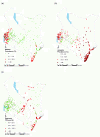Implementing school malaria surveys in Kenya: towards a national surveillance system
- PMID: 21034492
- PMCID: PMC2984573
- DOI: 10.1186/1475-2875-9-306
Implementing school malaria surveys in Kenya: towards a national surveillance system
Abstract
Objective: To design and implement surveys of malaria infection and coverage of malaria control interventions among school children in Kenya in order to contribute towards a nationwide assessment of malaria.
Methods: The country was stratified into distinct malaria transmission zones based on a malaria risk map and 480 schools were visited between October 2008 and March 2010. Surveys were conducted in two phases: an initial opportunistic phase whereby schools were selected for other research purposes; and a second phase whereby schools were purposively selected to provide adequate spatial representation across the country. Consent for participation was based on passive, opt-out consent rather than written, opt-in consent because of the routine, low-risk nature of the survey. All children were diagnosed for Plasmodium infection using rapid diagnostic tests, assessed for anaemia and were interviewed about mosquito net usage, recent history of illness, and socio-economic and household indicators. Children's responses were entered electronically in the school and data transmitted nightly to Nairobi using a mobile phone modem connection. RDT positive results were corrected by microscopy and all results were adjusted for clustering using random effect regression modelling.
Results: 49,975 children in 480 schools were sampled, at an estimated cost of US$ 1,116 per school. The overall prevalence of malaria and anaemia was 4.3% and 14.1%, respectively, and 19.0% of children reported using an insecticide-treated net (ITN). The prevalence of infection showed marked variation across the country, with prevalence being highest in Western and Nyanza provinces, and lowest in Central, North Eastern and Eastern provinces. Nationally, 2.3% of schools had reported ITN use >60%, and low reported ITN use was a particular problem in Western and Nyanza provinces. Few schools reported having malaria health education materials or ongoing malaria control activities.
Conclusion: School malaria surveys provide a rapid, cheap and sustainable approach to malaria surveillance which can complement household surveys, and in Kenya, show that large areas of the country do not merit any direct school-based control, but school-based interventions, coupled with strengthened community-based strategies, are warranted in western and coastal Kenya. The results also provide detailed baseline data to inform evaluation of school-based malaria control in Kenya.
Figures



References
-
- Sievers AC, Lewey J, Musafiri P, Franke MF, Bucyibaruta BJ, Stulac SN, Rich ML, Karema C, Daily JP. Reduced paediatric hospitalizations for malaria and febrile illness patterns following implementation of community-based malaria control programme in rural Rwanda. Malar J. 2008;7:167. doi: 10.1186/1475-2875-7-167. - DOI - PMC - PubMed
Publication types
MeSH terms
Grants and funding
LinkOut - more resources
Full Text Sources
Medical

